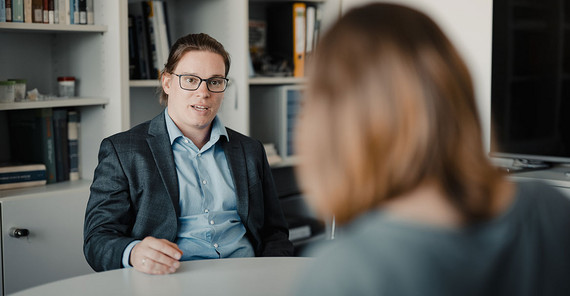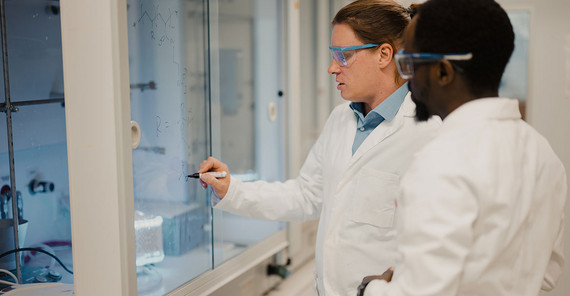The World Health Organization (WHO) sees the rapid development of antibiotic-resistant germs as one of the ten greatest global threats to human health. “Bacteria and fungi have carried resistance genes since prehistoric times,” Hartlieb says. The frequent use of antibiotics, however, creates an environment in which mainly resistant bacteria can survive and therefore spread more easily.” They primarily occur where a lot of antibiotics are used – for example in hospitals or in lifestock farming – and get into the environment via wastewater. Every year, over 1.2 million people worldwide die from antibiotic-resistant germs. People with a weak immune system, transplanted patients, cancer patients undergoing chemotherapy, or patients undergoing surgery are particularly at risk of infection.
Bottlebrush polymers as antibiotics
“Our vision is to develop synthetic, water-soluble polymers that can be used in treating bacterial infections in humans in the same ways as we now use antibiotics, for example as tablets or injections,” Hartlieb says. Since these polymers attack the bacterial membrane, bacteria can hardly develop any resistance to them. “They have properties that are also found in antimicrobial peptides, which our immune system uses to regulate and ward off bacteria,” he adds. The peptides or polymers carry positive charges and can attach to the cell membrane of the bacteria, which is negatively charged.
Polymers are long molecular chains that consist of many identical parts. We know them, for example, as plastics such as polyester or polyethylene. In nature, they occur as carbohydrates such as cellulose and starch in plants or as proteins in cells. However, as simple long molecular chains, the polymers from Hartlieb’s laboratory do not produce any significant effect on bacterial cell membranes. A lot of basic research is still needed to improve their antibacterial effect so as to be able to use them in therapy. “We work with so-called bottlebrush polymers, each individual bristle of which represents a polymer,” he explains. This special architecture bundles many polymers in a small space, which then can attack the membrane of the bacterium more effectively.
Activity and selectivity of the polymers are decisive
An essential finding of the first funding period is that the structure of the used polymers strongly influences their bioactivity and selectivity. The activity quantifies the antimicrobial effect of the polymer, while the selectivity is a measure of how well it can differentiate between bacteria and body cells. The selectivity of a conventional antibiotic is very high. “That’s our benchmark,” Hartlieb emphasizes. To this end, the researchers are systematically testing different lengths and shapes of the brush polymers. For the bacterial tests, the group is cooperating with the Fraunhofer Institutes for Cell Therapy and Immunology (IZI-BB) and for Applied Polymer Research (IAP) in Golm.
Hartlieb and his team first want to find out how much polymer is needed to stop the growth of bacteria. The rule is: the less, the better. “We varied the architecture of the brush polymers until we found the optimum aspect ratio of the brushes,” he explains. This made it possible to increase the selectivity from originally 32 to a value of 640, which means that the polymer is 640 times more effective against bacteria than against mammalian cells. “But there’s more to it,“ he is sure.
In collaboration with the Charité Berlin, the antibacterial polymers from the laboratory in Potsdam will soon be tested on animals. “Another focus during the second funding period will be biofilms that can form in wounds or on implants where bacteria are more difficult to combat,” Hartlieb summarizes. The promising results from the first funding period are good prerequisites for further steps towards an antibiotics alternative.
The Researcher
Dr. Matthias Hartlieb has been group leader of the Emmy Noether Junior Research Group “Polymeric Biomaterials” at the University of Potsdam since 2021.
Email: mhartliebuuni-potsdampde
The Project
“Next Generation Antimicrobial Polymers” has been funded by the German Research Foundation (DFG) as part of the Emmy Noether Junior Research Group since 2021. The second funding period has been approved recently and will start in 2024.
Participants: University of Potsdam
Funding: German Research Foundation (DFG)
Duration: 01/2021–12/2026
Further reading
Publications about this topic by the Hartlieb Group
A.-C. Lehnen, S. Kogikoski Jr., T. Stensitzki, A. AlSawaf, A. Bapolisi, M. Wolff, J. De Breuck, H. Müller-Werk- meister, S. Chiantia, I. Bald, M. N. Leiske, M. Hartlieb, “Anisotropy in Antimicrobial Bottle Brush Copolymers and its Influence on Biological Activity” Adv. Funct. Mater, 2023, 2312651, https://doi.org/10.1002/ adfm.202312651
A. M. Bapolisi, P. Kielb, M. Bekir, A.-C. Lehnen, C. Radon, S. Laroque, P. Wendler, H. M. Müller- Werkmeister, M. Hartlieb, “Antimicrobial Polymers of Linear and Bottlebrush Architecture: Probing the Membrane Interaction and Physicochemical Properties”, Macro. Rapid Comm., 2022, 43, https://doi.org/10.1002/marc.202200288
This text was published in the university magazine Portal Wissen - Eins 2024 „Bildung:digital“ (PDF).



